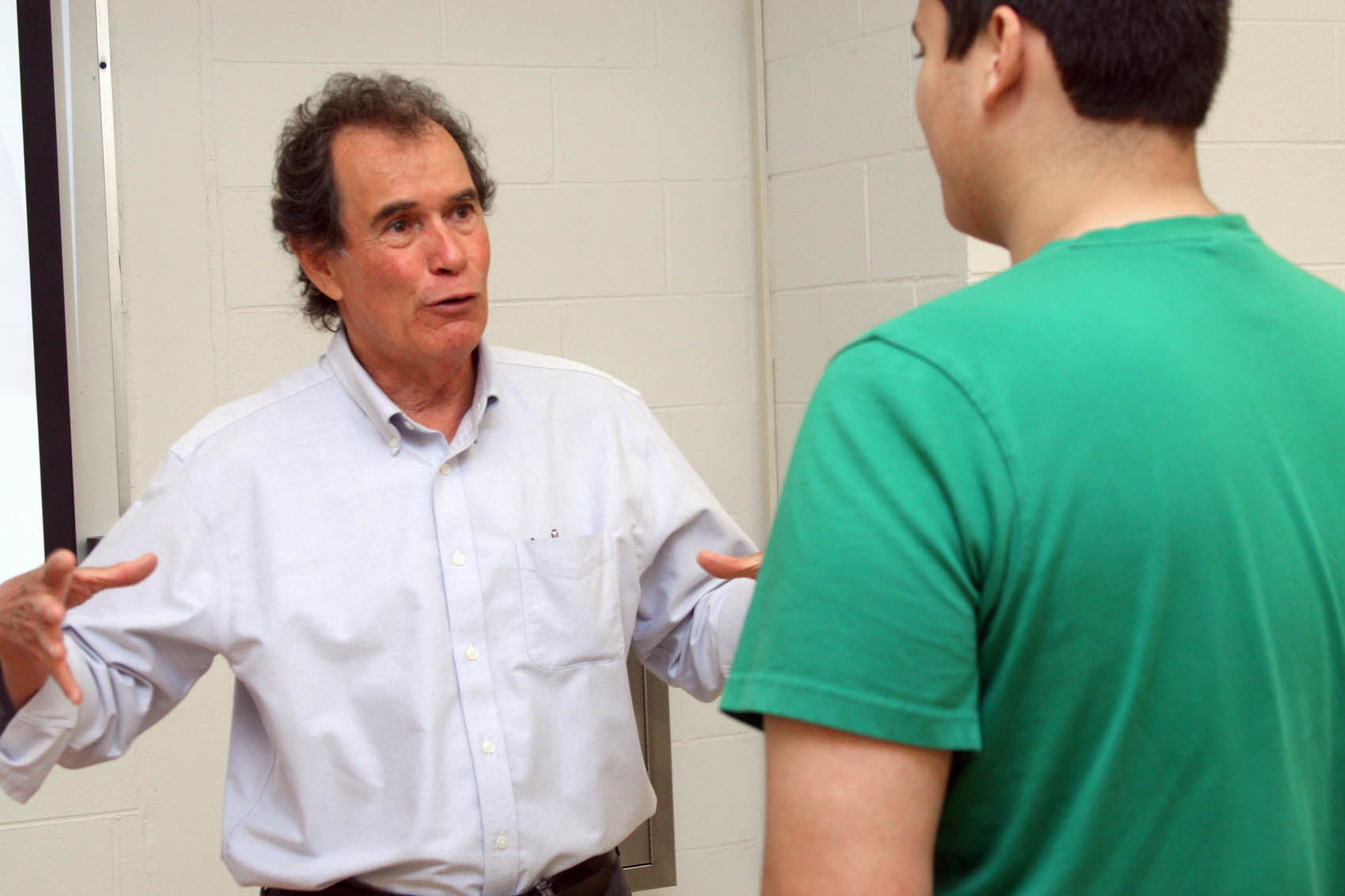College News
Pulitzer Prize winning photographer visits CCCC
Notice: This article is older than 12 months. Names, contact information, programs, titles, etc. might have changed. If you have any problems please call the main college number, 1-800-682-8353, and we will be happy to direct you accordingly.

click image to enlarge ⊗
Pulitzer Prize winning photographer Jose Galvez speaks with a Central Carolina Community College student ... (more)
05.03.2016 • College & Community • College General
SANFORD - Pulitzer Prize winning photographer Jose Galvez gave students a peek behind his lens and into his experience during a lecture and exhibition on April 22 at Central Carolina Community College in Sanford.
Renowned for his black-and-white images documenting Latino life in the United States, Galvez stood in front of a screen projecting his work while describing his own journey from a shoeshine boy growing up in a Mexican American household in Tucson to staff photographer at the Los Angeles Times, where he was part of a team that received the Pulitzer for a series on Latino life in southern California. Along the journey, he discussed topics ranging from immigration to the art of photography.
It was a mixture of humorous and poignant stories that began with one of the first he covered in North Carolina: the experience of a farmer in West Jefferson who crossed illegally into Texas as a teenager to work. After receiving amnesty in the late 1980s and moving to the Blue Ridge Mountains to work with Christmas trees, he became manager of the migrant workers and established his own growing operation.
"Jorge works for a large tree farmer, but he's also his own boss," Galvez told the students as photos from the tree farm faded in and out behind the narrator. "He spent the last couple of decades learning the business. He invested in his own lots and trees. In some cases, he owns the land; in others, just trees .... He hopes one day to have his tree in the White House."
As remarkable as that story was, Galvez's own story is even more inspiring.
Describing himself as "a natural born hustler" early in life, Galvez recounted how he sold newspapers, collected boxes to exchange for cookies and even shined shoes after his father made him a shoeshine box, something that might not have seemed all that consequential at first. But when a reporter for the Arizona Daily Star called him upstairs one night for a shine, the 10-year-old saw his future.
"There was an energy and electricity in the room that was exciting to watch," Galvez recalled. "It hit me right there on the spot that I wanted to belong to this room. I wanted to make it my new home. Instead of selling papers, I wanted to be part of making it."
For years, Galvez made himself useful in the newsroom - shining shoes, running errands and studying the reporters, who became his mentors. He bought his first camera in a pawn shop during high school, went on to major in journalism at the University of Arizona and dove head first into his new career.
"That shoeshine box changed my life," he said.
Before the lecture, students walked through a small gallery of Galvez's photography -- an exhibition on Cesar Chavez, a farm worker and social activist whom the late Sen. Robert F. Kennedy described as "one of the heroic figures of our time." Chavez, who died 23 years ago, co-founded the National Farm Workers Association to improve working conditions for field workers and received a number of honors for promoting civil rights.
Galvez said he chose this portion of his extensive portfolio to celebrate National Farmworker Awareness Week, a commemoration held each spring to highlight issues confronting farm workers in the United States. "I take this time to remember Cesar's contribution," Galvez explained. "There are real issues still for farm workers in the U.S. that need to be remembered and not forgotten."
After Galvez's formal presentation, students asked questions. Why does he shoot only with black and white film? It focuses his work and forces him to make every image count. And why, with Latino culture being such a large part of the national identity, does he think some contemporary politicians seem to be attacking it? That was one that made the photographer pause before giving his perspective on how changing demographics and fear can drive political sentiment.
Then there was another question: After experiencing such acclaim documenting the Latino experience, has he ever been tempted to branch out into other subjects? "No," Galvez said, shaking his head. "This has always been my calling."
For more information on Central Carolina Community College, visit the website at www.cccc.edu.
Categories
- Admin, Faculty & Staff Category
- Arts & Entertainment Category
- Clubs Category
- College & Community Category
- College General Category
- Continuing Education Category
- Curriculum Programs Category
- Distance Education Programs Category
- Facilities/Buildings Category
- Finances Category
- Foundation Category
- Graduations Category
- Lee Early College Category
- NCCCS Category
- SGA Category
- Special Events Category
- Sports Category
- Students/Graduates Category
- Uncategorized Category
Archives

